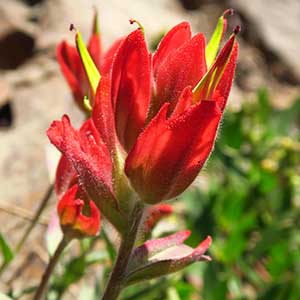Castilleja foliolosa
Castilleja elmeri
felt paintbrush, Texas Indian paintbrush, Texas paintbrush, woolly Indian paintbrush, woolly paintbrush
Elmer's Indian paintbrush, Elmer's paintbrush, Wenatchee Indian paintbrush, Wenatchee paintbrush
many, ascending, white or grayish due to hairs branched, much-branched proximally, unbranched to sometimes branched on distal 1/2, also usually with short axillary branches, base often shrubby and with marcescent leaves of previous year, hairs dense, appressed to spreading, medium length, soft, much-branched, eglandular, white-woolly, obscuring surface.
solitary or few to many, erect to ascending, sometimes slightly curved at base, unbranched, rarely branched, hairs moderately dense, spreading, medium length, soft, mixed with shorter eglandular and stipitate-glandular ones, at least on distal 1/2 of stem.
whitish or grayish, linear to narrowly lanceolate or narrowly oblong, 0.9–5 cm, not fleshy, margins plane, involute, 0–3-lobed, apex obtuse to rounded;
lobes divergent, spreading, linear, apex acuminate to acute.
green, rarely purple-tinged, linear-lanceolate, sometimes linear or lanceolate, 1.3–6.5 cm, not fleshy, margins plane, flat or involute, entire, apex acute.
2.5–20 × 1.5–3 cm;
bracts proximally green to dull pale purplish, distally red, scarlet, rose, yellow, orange, or cream, sometimes pink or white, lanceolate to oblanceolate, (0–)3–5-lobed;
lobes spreading, or distal ones erect, often oblanceolate, if 5-lobed, distal lobes usually very shallow, long or distal short, proximal bracts arising below mid length, distal ones arising near apex, apex rounded to truncate.
2.5–9 × 1.5–3 cm;
bracts red, crimson, scarlet, pink, magenta, red-orange, burnt orange, orange, pale yellow, or whitish throughout, or proximally greenish, distally as stated above, oblong, narrowly obovate, elliptic-oblong, or narrowly ovate, 0(–5)-lobed, rarely with 1 or 2 pairs of short, usually distal lobes;
lobes ascending, lanceolate, very short, arising from distal edge, apex rounded to obtuse.
0 mm.
straight or slightly curved, 16–27 mm;
tube (8–)10–12(–14) mm;
beak exserted or partially so, adaxially green, (7–)8.5–14 mm;
abaxial lip deep green, reduced, 1–3 mm, 20–33% as long as beak;
teeth incurved, reduced, green, 0.5 mm.
straight, 20–33 mm;
tubes 13–18 mm;
beak, and sometimes abaxial lip, partially to fully exserted;
beak adaxially green to yellowish, 8–15 mm;
abaxial lip incurved, green, thickened, 2–3 mm, 20–33% as long as beak;
teeth ascending or incurved, green, 0.5–1 mm.
proximally green, apices colored as bracts, 14–20(–22) mm;
abaxial and adaxial clefts 3.5–7(–9) mm, 33–40% of calyx length, deeper than laterals, lateral 0(–1) mm, 0(–7)% of calyx length;
lobes broadly triangular, apex of lobes and segments broadly rounded to truncate, segments, if present, obtuse.
proximally green to pale green, distally colored as bracts, 15–25 mm;
abaxial and adaxial clefts 5–14 mm, 33–50% of calyx length, deeper than laterals, lateral 1–4 mm, 6–20% of calyx length;
lobes lanceolate to narrowly triangular, apex rounded to obtuse.
= 24.
= 48.
Castilleja foliolosa
Castilleja elmeri
Castilleja foliolosa inhabits chaparral from northern California southward to northern Baja California, west of the Sierra Nevada crest. The inflorescence is usually red or red-orange but can vary to white, yellow, pink, or purple. It is present on Santa Catalina Island in the southern Channel Islands, Los Angeles County, but is replaced in the northern Channel Islands by C. hololeuca, a related shrubby species. Castilleja foliolosa hybridizes with C. martini var. martini in San Diego County.
(Discussion copyrighted by Flora of North America; reprinted with permission.)
The bracts and inflorescences of Castilleja elmeri can be red, crimson, scarlet, pink, magenta, red-orange, burnt orange, orange, pale yellow, or whitish. While the coloration is highly variable between local populations, it is usually uniform and consistent within them. It is found primarily in the Wenatchee Mountains of Washington, where it is often on serpentine, but it ranges northward in the Cascades into extreme southern British Columbia, apparently on non-serpentine substrates. Hybrids with C. miniata var. miniata, C. parviflora var. albida, and C. thompsonii have been found in the eastern Cascades of Washington, and a similar hybrid swarm with C. thompsonii is reported from southern British Columbia.
(Discussion copyrighted by Flora of North America; reprinted with permission.)


